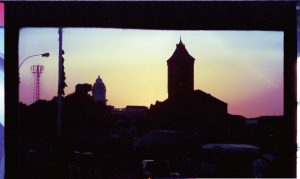Ambient music, like all electronic music, often displays an uneasy relationship between the final composition & the source materials from which it was made. i believe it was Luc Ferrari who coined the term ‘anecdotal’ for sounds that immediately declare their origins; while field recordings, as an art form, have become an entity in their own right these days, for some, use of such anecdotal sounds is anathema, rupturing the delicate abstract surface for which they strive. There are times when it seems as though Celer echo this sentiment; one only has to spend a little time with Poulaine, for instance, which lists cello, violin, theremin, “contact mics on oil paintings” & field recordings among other things as its sources, all of which are entirely lost, unidentifiable in the resultant ambient soup. That’s not exactly a complaint; i know from experience that the significance of a source can be justification enough for inclusion, irrespective of whether or not its identity is retained—this is music, after all, not documentary footage—&, in any case, on other releases Will & Dani have, indeed, allowed their sources to be more obviously demonstrative, such as Poulaine’s companion release Fountain Glider & Engaged Touches.
It’s particularly striking, then, that the opening track of Generic City, a collaboration by Celer & sound artist Yui Onodera, begins amidst an obvious field recording of the calls & honks of a large flock of what sound like swans. Titled “An Imaginary Tale of Lost Vernacular”, one detects, early on, that ambient textures are present, but they are kept at bay for some minutes before moving into the foreground. This sets the tone for the rest of the album, one in which overtly anecdotal sounds happily coexist with abstract textures; no hints of unease here. Having said that, a lack of unease can’t of itself make the abstract & anecdotal gel—nothing could—yet what Onodera & Celer establish in this track is a continuum of sorts, the music moving freely within the abstract & anecdotal poles, thereby attaining some semblance of unification. Once the abstract material has emerged, it dominates the track, but anecdotal sounds are forever lurking at the fringes, more muted than before, but thereby becoming more allusive, encrusting the music with bells & chimes, until it returns to the fore for the closing minutes. As the track ends, we move back to the anecdotal extreme, & the stark unadorned sound of footsteps walking on gravel; such a world away from that with which most of the previous quarter of an hour has been preoccupied, yet not feeling out of place.
“Waiting Until Something Else Happens” goes further, seeking to integrate the two kinds of material more thoroughly. It opens in pure ambience, the music softly rising & falling, but noise quickly takes up position at the edges once again; over time, the noise begins to make inroads, its gestures adorning & ultimately overwhelming the more gentle tones beneath. They usher in the track’s central section, a protracted episode where field recordings made at an airport take centre stage, culminating in more noise, the combination of plane sounds & water, blurring the distinction between the raw & the cooked; it’s impossible to tell, in fact, what’s sonically ‘real’ & what’s not at moments like this. The final couple of minutes are a stylistic recapitulation of sorts, all ambience, an exercise in gorgeous shimmering.
From the first couple of tracks, it’s clear that unification works best when the sharp, anecdotal edge of the field recordings is blunted somewhat, & this is demonstrated early on in “The Street Of A Rainy, Gray Day”. It’s a much more complex track, the foreground in flux, both kinds of material juxtaposed in quick succession. Generic City’s most effective moments are heard here; a sense of the abstract is what projects most, but one is constantly aware of fragments & gestures hinting at something familiar, tantalisingly kept just beyond the reach of recognition. Once again, this is diffused into a dense cloud of noise, before a strident chord, laden with pulsing overtones, appears, propelling the track in a new direction. For the rest of its duration, the impetus is maintained; field recordings often push to the front, yet for all their clarity, direct recognition remains difficult. Material constantly morphs back & forth, teasing the ear at the cusp of identity, one moment forming amorphous oscillations, another dissolving into a vast texture of busy street noise. There’s not one moment of this track that fails to engage & ignite the imagination, & it’s a very fine example indeed of the kind of fascinating interplay that can result from such disparate types of source material.
Generic City closes with “A Renewed Awareness of Home”, a mysterious slab of sound occupying a darker ambient world. The first four minutes are masterful; a viscous miasma is established, moving with the pace of tectonic plates, hypnotising the ear. The first occurence of something other comes as a shock (in fact, on first listening i actually believed the sound to have come from somewhere else); metallic strikes periodically blanch the surface of the ambient cloud, causing it to shift & alter in consistency. It’s magical stuff; unfortunately, the entrancing mood is emphatically broken by the ensuing abrupt appearance of chanting voices. In theory, such sounds ought to fit right in with the established soundworld; sadly, however, they jar unpleasantly, shattering the carefully balanced texture, the opening few minutes quickly lost & forgotten. The field recordings finally subside into another abstract episode, but it’s an altogether brighter one, & as such, only seems to worsen the overall effect.
This is, however, a very rare example of ill-judged/executed sound juxtaposition from these otherwise superb musicians; & despite the difficulties of the final track, Generic City is otherwise a tour de force of electroacoustic music. It’s really exciting to hear the anecdotal & the abstract co-exist in such a unified & fruitful way.
http://5-against-4.blogspot.com/


